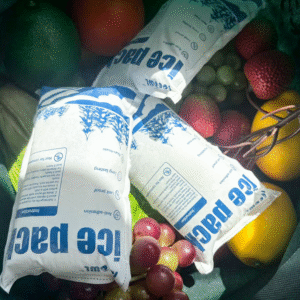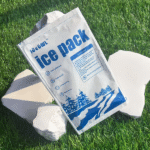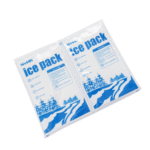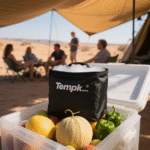Comment utiliser un pack de glace sec pour expédier des aliments (2025)
Mis à jour: Août 19, 2025
Tu veux un Pack de glace sec pour expédier des aliments qui assure la sécurité des produits, conforme, et rentable. En termes simples: Utilisez de la glace sèche lorsque vous avez besoin d'Ultracold, Utilisez des «calottes glaciaires» ou PCM hydratés (changement de phase) panneaux pour voies refroidies ou −20 ° C, et la droite du liquide de refroidissement par le temps et l'isolation. La vraie glace sèche nécessite des étiquettes de ventilation et UN1845; Les packs hydratés / PCM ne sont pas.
-
Quel pack de glace sec pour expédier la nourriture est vraiment (Et quand les "calottes glaciaires" ne sont pas co₂)
-
Combien de packs de glace sec pour expédier la nourriture dont vous avez besoin en utilisant des règles rapides et une calculatrice
-
Comment emballer un pack de glace sec pour expédier de la nourriture étape par étape pendant 24 à 72 heures
-
Quoi 2025 Les règles d'expédition nécessitent pour les étiquettes, limites aériennes, et guidage postal
-
Lorsque le gel ou le PCM bat un pack de glace sec pour l'expédition de nourriture dans de vraies voies
Qu'est-ce qu'un sac à glace sec pour expédier de la nourriture - et quand n'est-ce pas de vraie glace sèche?
Réponse courte: Beaucoup "Fiches de glace sèche" sont Couvertures de glace en polymère hydraté ou panneaux PCM vous gelez et réutilisez; ils sont pas co₂ solide. La vraie glace sèche est le dioxyde de carbone à -78,5 ° C (−109,3 ° F) que sublimer le gaz, Les forfaits doivent donc évacuer et transporter UN1845 marques. Utilisez Hydrated / PCM pour les prises refroidies ou −20 ° C; Utilisez une vraie glace sèche pour les courses ultracold ou longues.
Pourquoi ça compte pour toi: Les feuilles hydratées et le PCM ne sont pas hazmats et simplifient la formation; La vraie glace sèche ajoute l'étiquetage, ventilation, et les détails de réservation. Pour la sécurité alimentaire, Tenez des articles réfrigérés à ≤40 ° F par livraison; Utilisez 0 ° F pour les cibles du congélateur.
Fiches de glace sèches vs. gel VS. PCM VS. vraie glace sèche (Lequel devez-vous choisir?)
Produits enveloppés de «feuilles de glace sèche hydratées, congeler à plat, et briller pour 33–40 ° F cale. Packs de gel sont simples et réutilisables pour les voies réfrigérées. Panneaux PCM (Par exemple, ~ 5 ° F ou −20 ° C) agir comme une «batterie thermique,«Bridging refroidi↔frozen sans danger. Vraie glace sèche gagne lorsque «Arrive Rock - Solid Frozen» n'est pas négociable ou le transit est de 48 à 72 h +.
| Réfrigérant | Température typique | Patrie? | Ce que cela signifie pour vous |
|---|---|---|---|
| «Fiches glaciaires» hydratées | ~ 10–32 ° F pendant 24–48h | Non | Enveloppement flexible pour les kits de repas et un colis court. |
| Packs de gel | ~ 20–32 ° F pendant 24–48h | Non | Faible coût, Manipulation facile pour des pistes de 2 à 8 ° C. |
| Panneaux PCM (≈5 ° f / −20 ° C) | Plateau plat à la configuration | Non | Frozen - assisté ou −20 ° C tient sans DG. |
| Vraie glace sèche (Co₂) | −109,3 ° F / −78,5 ° C | Oui | Meilleur pour ultracold / long congelé; secouer & Étiquette un1845. |
Conseils pratiques que vous pouvez appliquer aujourd'hui
-
Kits de repas (48 H): Murs de ligne et garnir de draps hydratés; Ajouter une brique PCM de 5 ° F contre les protéines pour une stabilité plus froide.
-
Desserts congelés: Lieu glace sèche sur le dessus (puits d'air froid) et ajouter une fine couche de feuille / PCM pour protéger les surfaces; évacuer la boîte.
-
Routes chaudes: Ajouter 25–50% Plus d'isolation de masse de feuille / gel ou de mise à niveau (Par exemple, Revêtements VIP).
Vraie cas: Une boulangerie a remplacé les charges de glace tout Deux briques PCM + Trois draps hydratés pour les réseaux cestres et tenus 34–38 ° F Plus de 36h, Élimination des surtaxes DG. Les réseaux surgelés ont gardé un petit dessus de la glace sec pour les arrivées «rock-solid».
De combien de packs de glace sec pour expédier de la nourriture avez-vous besoin par jour?
Règles rapides qui fonctionnent:
-
Glace sèche (Vrai co₂): plan ~ 5 à 10 lb par 24h par boîte isolée; augmenter les glacières plus gros, murs fins, ou chauffer.
-
Draps / gel hydratés (glacé): à propos 1 LB par pied cube par 24h contenir 33–40 ° F; Ajouter 25 à 50% pour les voies chaudes.
-
Panneaux PCM: taille couverture et point de consigne (Par exemple, −20 ° C); Conditionnement entièrement préalable par fournisseur.
Points de départ que vous pouvez copier:
-
25Expéditeur de T-T: ~ 10 lb de glace sèche pour 24h, ou 2–3 draps + 1 Brique PCM pour réfrigéré.
-
45Expéditeur de T-T: 15–20 lb glace sèche pour 24h, ou 4–5 draps + 2 Briques PCM pour réfrigéré.
Comment emballer un pack de glace sec pour expédier de la nourriture, pas à pas?
Faire: Hydrate ou condition préalable → Freeze Solid → Envelopper → Masse froide à charge supérieure → Joint (Évent si vous utilisez Co₂). Gardez les produits pré-chimiés à ≤40 ° F ou pré-infro a à 0 ° F pour éviter les pointes de température précoces.
-
Conditionner le liquide de refroidissement:
-
Draps hydratés: côté trempé, vidange, et Freeze Flat 24h.
-
PCM: geler à un point de consigne étiqueté (Par exemple, −20 ° C) jusqu'à ce qu'ils soient entièrement solides.
-
-
Envelopper la charge utile: Ligne du fond et des côtés; Remplissez tous les vides Pour arrêter les boucles d'air chaudes.
-
Ajouter la couche supérieure: Masse froide sur le dessus; couvercle ventilé Si vous utilisez une vraie glace sèche.
-
Fermer et étiqueter: Ajouter un enregistreur de données, sceller l'expéditeur, Appliquer des marques si un co₂ est utilisé.
Avez-vous vraiment besoin de gel / pcm au lieu d'un pack de glace sec pour expédier des aliments?
Si votre spécification est 2–8 ° C ou −20 ° C Dans les 24 à 48 h, gel ou PCM frappe souvent la cible avec moins de manipulation et pas de danger. Pour 48–72h ultracold ou «arrive rock-solid,» glace carbonique règles encore. De nombreuses équipes courent maintenant hybrides: PCM autour du produit plus un petit dessus de la glace sec pour une chaleur la pire..
Est un pack de glace sec pour l'expédition de nourriture autorisée par 2025 transporteurs?
Oui, avec des détails:
-
IATA DGR 66th (2025): marque «Dioxyde de glace sèche / carbone, solide", UN1845, et poids net (kg); assurer ventilé conditionnement; Utiliser le 2025 liste de contrôle d'acceptation Lorsque la glace sèche est la seule DG.
-
Notes de transporteur (2025): FedEx / UPS suivent les règles de l'IATA à l'échelle internationale et domestique; Vérifiez leurs aides à l'emploi pour les tailles d'étiquette et le placement de la même face avec la classe 9.
-
USPS (courrier aérien): ≤5lb par morceau, récipient ventilé, Un1845 côté adresse; Le courrier international avec de la glace sec est interdit.
-
Vols de passagers: 2.5 kg (5.5 kg) par passager par colis, Approbation des compagnies aériennes requises, emballage ventilé et marqué. Les packs gel / pcm peuvent voler dans le transport congelé à la projection.
2025 Tendances pour le pack de glace sèche pour l'expédition de nourriture
Quoi de neuf cette année: plus clair Iata étiquetage et Net - kg Pratiques de réservation, Utilisation plus large de PCM à -20 ° C Pour réduire les points de contact Hazmat, et des rappels réguliers pour tenir des aliments réfrigérés à ≤40 ° F. Meilleure isolation (Par exemple, Revêtements VIP) signifie moins de masse de liquide de refroidissement sur de nombreuses voies - bon pour le coût et les réclamations.
Dernières avancées en un coup d'œil
-
Acceptation de la liste de contrôle: Moins de surprises de transfert lorsque l'UN1845 et le net-kg sont corrects.
-
Emballages hybrides: PCM + feuilles de réflexion, Topper de la glace sec pour les cas de bord.
-
CO₂ CO₂ de travail: 5,000 ppm twa / 30,000 PPM Stel - Ventilate de stadification.
Perspicacité du marché: La mise à niveau de l'isolation économise souvent plus que l'ajout de liquide de refroidissement. Valider chaque voie avec bûcherons de données et verrouiller le sop une fois que les performances sont prouvées.
FAQ: Questions courantes sur le pack de glace sèche pour l'expédition de nourriture
Q1: Un pack de glace sec pour l'expédition de nourriture gardera les articles congelés pendant 2 à 3 jours?
Souvent Oui avec une vraie glace sèche dimensionnée 5–10 lb / 24h, grande isolation, et emballage serré. Pour −20 ° C Spec, Le PCM peut remplacer une certaine ou toutes la glace sèche.
Q2: Sont des «calottes glaciaires» hydratées comme un pack de glace sèche pour expédier des aliments?
Non. Les draps hydratés et le PCM sont pas co₂; ils gèlent et Ne pas évacuer le gaz. La vraie glace sèche est co₂ et a besoin de ventilation / étiquettes.
Q3: De combien de feuille ou de gel hydraté ai-je besoin avec mon pack de glace sec pour expédier des aliments?
Commencer à proximité 1 lb par ft³ par jour pour les prises réfrigérées, puis ajustez après un pilote avec un bûcheron.
Q4: Quelles températures devrais-je cibler pour la sécurité lors de l'utilisation d'un pack de glace sec pour expédier des aliments?
Gardez les aliments réfrigérés à ≤40 ° F fin à fin; Gardez les articles congelés à 0 ° F ou ci-dessous avant l'emballage.
Résumé & recommandations
Points clés: Choisissez le Pack de glace sec pour expédier des aliments en fonction de la température et de la durée cibles. Utiliser hydraté / PCM pour refroidie ou −20 ° C sans danger; utiliser vraie glace sèche pour ultracold ou long congelé. Commencer par 1 lb / ft³ / jour pour les draps / gel et 5–10 lb / 24h pour la glace sèche, alors Valider avec un enregistreur. Étiquette UN1845 et évacuer chaque fois que le co₂ est utilisé.
Étapes suivantes (Copiez ce plan):
-
Définissez votre voie (temp + heures). 2) Choisir le liquide de refroidissement (Feuille / PCM VS. glace carbonique). 3) Utilisez les règles de dimensionnement et exécutez un pilote. 4) Standardiser votre SOP avec des photos et une liste de contrôle. Besoin d'un emballage spécifique à la voie? Faites défiler vers le CTA ci-dessous.
À propos du tempk
Nous concevons des emballages de chaîne froide validés qui frappent vos cibles à temps de température au Coût à l'atterrissage le plus bas. Nos ingénieurs Benchmark draps hydratés, gel, PCM, et glace sèche combinaisons, puis livrer des sops clairs, modèles d'étiquette, Et s'entraîner pour que votre équipe expérimente en toute confiance -. Parlez à un spécialiste du tempk Pour un examen de l'emballage gratuit de 15 minutes.
























